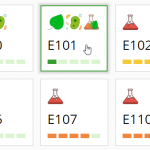
There are widespread opinions in society about the harm of food additives with the "E" code. Partly, this is because no country in the world has an officially approved, unified system for classifying additives by their harmful impact on the human body. At most, what is outlined in the legislation of most countries is a list of permitted and prohibited additives for use in the food industry.
To help you understand how harmful a particular additive is to our body, we are introducing our own system of classification based on the level of its impact on our health.
We divide all additives into 6 levels of danger, from "zero" to "very high." We do not classify additives by the principle of "like it – don’t like it" or by using dubious data. Our evaluation system is based on the origin of the additive, the method of its production, and scientific research. Using this system, any additive can be clearly classified into a specific level based on characteristic signs.
For the basic, zero level, we take natural additives (of plant, animal, or mineral origin) that have a positive effect on human health. Essentially, these are various vitamins and minerals that naturally enter our bodies through the consumption of natural foods. Organizations that monitor food production technologies do not set maximum daily intake limits for such additives, and they are considered absolutely safe for human health worldwide. In addition, these additives can sometimes have a positive effect by reducing the risk of certain diseases and strengthening the human immune system.
Additives obtained artificially, also called "identical to natural," are assigned one negative point. From a scientific standpoint, these are "exact copies" of natural additives, but when synthesizing them into the final product, metal impurities or other by-products of chemical reactions may still end up in the product.
Additives that are not found in nature and are obtained only through synthesis receive two negative points, as these additives are not characteristic of the human body and are currently poorly studied.
If scientific research shows that consuming products containing a certain additive can cause negative effects in part of the population, such as allergic reactions, elevated blood pressure, digestive disorders, and other "mild" diseases, the additive is assigned two negative points.
In the case of scientific evidence of more serious effects on human health, the additive receives three negative points. The description of such additives will include a link to the research results and the primary source of the studies.
For a more objective assessment, we reserve the right to make slight adjustments (within one point) in either direction based on scientific data about the additive’s effects on the body. For example, some additives obtained from plants may increase the risk of cancer. For such additives, we add one negative point. At the same time, some artificial or even synthetic additives (such as carotenoids, vitamins A, B, C, etc.) have a positive effect on the body. For such additives, we will add one positive point.
Thus, by summing up all the negative or positive factors, we can fairly accurately assign an additive to a specific level of danger.
We do not advocate taking our evaluation method as the benchmark. However, we believe that this system will help you quickly get a general idea of the origin of an additive and its effects on the human body, without delving into the detailed description of the additive and scientific research results. At the same time, if you often consume products with a particular E-additive, we recommend that you study all the information about this additive and draw your own conclusions about its harm or benefit to your body.